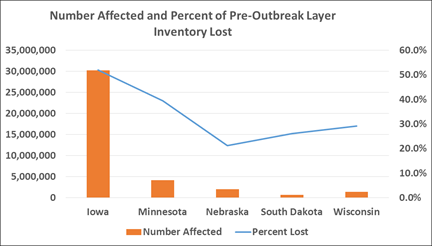Since the beginning of 2015, Highly Pathogenic Avian Influenza (HPAI) has resulted in the loss of more than thirty-eight million layers and pullets in the U.S. from infection or depopulation due to exposure to the virus. Layer operations affected by HPAI are in Iowa, Minnesota, Nebraska, Wisconsin, and South Dakota, and represent a significant percentage of pre-outbreak inventories, particularly for Iowa (52%) and Minnesota (nearly 40%). Since HPAI first began to spread throughout the country in early 2015, the rate of spread has slowed due to quarantines and warmer weather.

Even though the rate of spread has declined, the industry will face headwinds for a significant period of time. Many affected by the outbreak expect to take 18-24 months before reaching pre-outbreak production levels due to quarantine requirements, access to pullets, and a desire to maintain a desired age distribution among layers. Egg producers able to sell eggs, as well as consumers, can expect to be in an elevated price environment for at least the next 6-9 months.
The purpose of our analysis was to quantify the economic impact of HPAI on the nation's poultry industry in particular and the economy at large. The IMPLAN modeling system was used to estimate this impact. Additional sources of data include USDA/Animal and Plant Health Inspection Service (APHIS), USDA/National Agricultural Statistics Service (USDA/NASS), Egg Industry Center (EIC) at Iowa State University, and the Livestock Marketing Information Center (LMIC).
Results from our analysis include:
- 15,693 fewer jobs
- $2.6B in lower Output
- $981.0M in lower Value-Added
- Total federal tax receipts are estimated to decrease by: $248.6M
- Total state and local tax receipts are estimated to decrease by: $136.1M
Check out our full study here.
Be sure to watch for a forthcoming study detailing both the loss of layers and turkeys to Iowa's economy in the near future.

